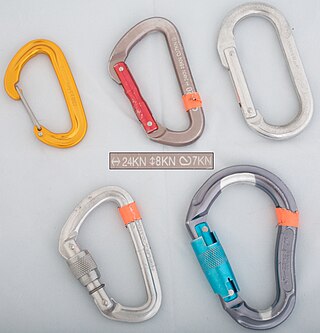
A carabiner or karabiner, often shortened to biner or to crab, colloquially known as a (climbing) clip, is a specialized type of shackle, a metal loop with a spring-loaded gate used to quickly and reversibly connect components, most notably in safety-critical systems. The word comes from the German Karabiner, short for Karabinerhaken, meaning "carbine hook," as the device was used by carabiniers to attach their carbines to their belts.

A knot is an intentional complication in cordage which may be practical or decorative, or both. Practical knots are classified by function, including hitches, bends, loop knots, and splices: a hitch fastens a rope to another object; a bend fastens two ends of a rope to each another; a loop knot is any knot creating a loop; and splice denotes any multi-strand knot, including bends and loops. A knot may also refer, in the strictest sense, to a stopper or knob at the end of a rope to keep that end from slipping through a grommet or eye. Knots have excited interest since ancient times for their practical uses, as well as their topological intricacy, studied in the area of mathematics known as knot theory.
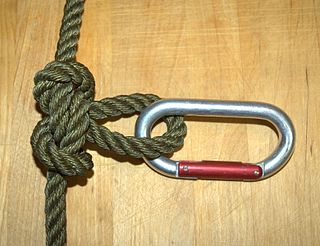
The butterfly loop, also known as lineman's loop, butterfly knot, alpine butterfly knot and lineman's rider, is a knot used to form a fixed loop in the middle of a rope. Tied in the bight, it can be made in a rope without access to either of the ends; this is a distinct advantage when working with long climbing ropes. The butterfly loop is an excellent mid-line rigging knot; it handles multi-directional loading well and has a symmetrical shape that makes it easy to inspect. In a climbing context it is also useful for traverse lines, some anchors, shortening rope slings, and for isolating damaged sections of rope.

A shank is a type of knot that is used to shorten a rope or take up slack, such as the sheepshank. The sheepshank knot is not stable. It will fall apart under too much load or too little load.

The clove hitch is an ancient type of knot, made of two successive single hitches tied around an object. It is most effectively used to secure a middle section of rope to an object it crosses over, such as a line on a fencepost. It can also be used as an ordinary hitch, or as a binding knot, but it is not particularly secure in either application. It is considered one of the most important knots, alongside the bowline and the sheet bend.
Although the name clove hitch is given by Falconer in his Dictionary of 1769, the knot is much older, having been tied in ratlines at least as early as the first quarter of the sixteenth century. This is shown in early sculpture and paintings. A round turn is taken with the ratline and then a hitch is added below. The forward end is always the first to be made fast.
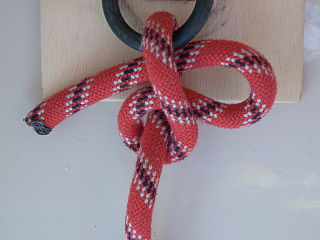
A slipped half hitch is a knot in which the weight of the load the rope carries depresses the loop sufficiently to keep it in place until the load item is placed in its location. When no longer required the free end may be pulled and draw the loop through and so release the load.

Glossary of climbing terms relates to rock climbing, mountaineering, and to ice climbing.

Rock-climbing equipment varies with the specific type of climbing that is undertaken. Bouldering needs the least equipment outside of climbing shoes, climbing chalk and optional crash pads. Sport climbing adds ropes, harnesses, belay devices, and quickdraws to clip into pre-drilled bolts. Traditional climbing adds the need to carry a "rack" of temporary passive and active protection devices. Multi-pitch climbing, and the related big wall climbing, adds devices to assist in ascending and descending fixed ropes. Finally, aid climbing uses unique equipment to give mechanical assistance to the climber in their upward movement.
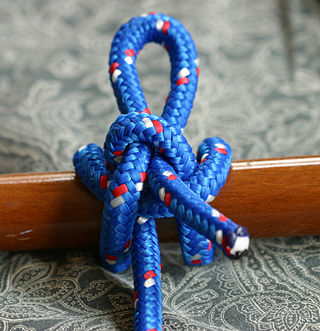
The Highwayman’s hitch is a quick-release draw hitch used for temporarily securing a load that will need to be released easily and cleanly. The hitch can be untied with a tug of the working end, even when under tension. The highwayman's hitch can be tied in the middle of a rope, and so the working end does not need to be passed around the anchor when tying or releasing.

In climbing and mountaineering, belaying comprises techniques used to create friction within a climbing protection system, particularly on a climbing rope, so that a falling climber does not fall very far. A climbing partner typically applies tension at the other end of the rope whenever the climber is not moving, and removes the tension from the rope whenever the climber needs more rope to continue climbing. The belay is the place where the belayer is anchored, which is typically on the ground, or on ledge but may also be a hanging belay where the belayer themself is suspended from an anchor in the rock on a multi-pitch climb.

The Munter hitch, also known as the Italian hitch, mezzo barcaiolo is a simple adjustable knot, commonly used by climbers, cavers, and rescuers to control friction in a life-lining or belay system. It is often mistakenly identified as the crossing hitch, however in the cross hitch the line does not return back along its original path.To climbers, this hitch is also known as HMS, the abbreviation for the German term Halbmastwurfsicherung, meaning half clove hitch belay. This technique can be used with a special "pear-shaped" HMS locking carabiner, or any locking carabiner wide enough to take two turns of the rope.

The Bachmann hitch is a friction hitch, named after the Austrian alpinist Franz Bachmann. It is useful when the friction hitch needs to be reset quickly or often or made to be self-tending as in crevasse and self-rescue.

A Prusik is a friction hitch or knot used to attach a loop of cord around a rope, applied in climbing, canyoneering, mountaineering, caving, rope rescue, ziplining, and by arborists. The term Prusik is a name for both the loops of cord used to tie the hitch and the hitch itself, and the verb is "to prusik" or "prusiking". More casually, the term is used for any friction hitch or device that can grab a rope. Due to the pronunciation, the word is often misspelled Prussik, Prussick, or Prussic.
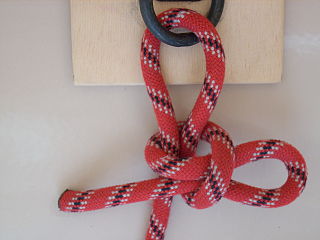
The halter hitch is a type of knot used to connect a rope to an object. As the name implies, an animal's lead rope, attached to its halter, may be tied to a post or hitching rail with this knot. The benefit of the halter hitch is that it can be easily released by pulling on one end of the rope, even if it is under tension. Some sources show the knot being finished with the free end running through the slipped loop to prevent it from working loose or being untied by a clever animal, still allowing easy but not instant untying.
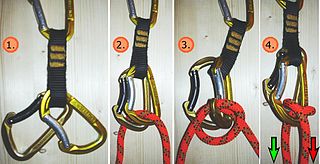
The Garda Hitch, also known as the Alpine Clutch, is a type of climbing knot that can only be moved in one direction. It is often used in climbing and mountaineering, such as in pulley systems to haul loads up a cliff. However, the Garda Hitch has some drawbacks, including being difficult to release under load, difficult to inspect, and adding significant friction to a pulley system. It can be challenging to determine which direction the rope will move freely and which direction it will lock just by looking at it. To tie a Garda Hitch, you need two similar carabiners, and it works best with two identical oval carabiners. While "D" carabiners can also be used, there is a risk of them unclipping.

Karash double loop is a common name for a knot forming two loops. This knot has been a known variant of the Bowline on a bight per the International Guild of Knot Tyers, referred to as bowline twist or twisted collar bowline on a bight. The knot is also referred to as nœud de fusion in French references and sometimes called Fusion knot in English.

A Tensionless hitch is an anchor knot used for rappelling or rope rescue. Unlike most knots, the tensionless hitch retains a 100% efficiency rating, meaning the strength of the knot is equal to the strength of the rope; it is not a significant stress riser.

The tumble hitch is a "slip-free", quick-release hitch knot used for temporarily securing a rope such that it can be released easily to be completely free of the hitched-to object. The hitch might be able to be released with a tug of the working end, even when under tension; but the workings depend upon materials and forces; note that in some cases, "under tension" will amount to simply being tied and the line itself giving significant tension by weight. The tumble hitch is tied in the bight.


















